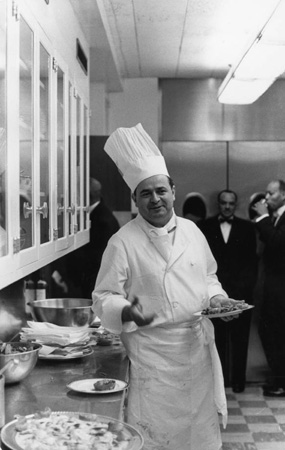When we first see Roger Sterling and Joan Holloway in a hotel room they’ve escaped to for one of their many trysts, Roger, who always travels first class, has a luncheon delivered to the room in an attempt to persuade her to stay the afternoon. Joan replies that she has to work, even if Roger doesn’t.
“Aren’t you even going to have any of this?” asks Roger. “Look, we’ve got Oysters Rockefeller. Beef Wellington. Napoleons. We leave this lunch alone it’ll take over Europe.”
“I don’t like eating in here,” replies Joan. “Food that close to the bed reminds me of a hospital.”
We doubt anyone but a president or a prince was ever served Beef Wellington made in a hospital kitchen. It is a dish fit for royalty, one served at lavish state dinners, the finest restaurants, and the most elegant homes. If Napoleons are the emperors of desserts, Beef Wellington is the king of all beef dishes and Roger, who had already bestowed jewelry on “Joanie,” was trying to make her feel like a queen.
Roger’s quip about Europe may have had more historical substance than he realized, for it was Arthur Wellesley, the First Duke of Wellington, who defeated Napoleon at Waterloo. Though the history of Beef Wellington is murky, it definitely originated in Europe and it is generally agreed the dish was named for the Duke.
Beef tenderloin cooked in a rich pastry crust and “embellished with pâté de foie gras, truffles and cognac” is the gold standard for the dish as described in the December 26, 1965, edition of the New York Times.
“Beef Wellington was the premier party dish of the 1960s,” wrote Sylvia Lovegren in Fashionable Food: Seven Decades of Food Fads (MacMillan, 1995). “It was rich, dramatic, expensive, and seemed difficult and time-consuming to prepare. In short, it was everything a gourmet dish should be.” That it had European origins only added to the allure, especially as Americans began embracing foreign cuisines with more gusto.
Beef Wellington was also a favorite of President and Mrs. Kennedy, and was the main course served at a White House dinner on April 29, 1962, honoring Nobel Laureates.
Because getting the beef and the pastry shell right was such a challenge—Marian Burros of the New York Times once wrote, after years of trying, that “a rare filet of beef and a flaky pastry are mutually exclusive”—some cooks outside the White House took shortcuts with the other ingredients. A recipe in Vogue in 1954, for example, suggested using canned pâté. And others, such as Betty Crocker’s Hostess Cookbook (1967), from which our recipe was adapted, dispense with the foie gras altogether. But we did turn to The White House Chef Cookbook by the Kennedys’ White House chef René Verdon (1968) for the pastry crust. If anyone knew how to get it right, he surely did.
We find it hard to believe Joanie could have said no to Beef Wellington, but imagine Roger found it almost as irresistible as Joan herself.

WHITE HOUSE CHEF RENÉ VERDON
ADAPTED FROM BETTY CROCKER’S HOSTESS COOKBOOK (GOLDEN PRESS, 1967); PASTRY FROM THE WHITE HOUSE CHEF COOKBOOK BY RENÉ VERDON (DOUBLEDAY, 1967)
NOTE: You can substitute 1 pound of premade piecrust or puff pastry for the homemade pastry.
Beef Wellington typically includes pâté de foie gras, a paste made of duck or goose livers, and a delicacy in French cuisine. Although the pâté is not included in this recipe, you can spread ½ pound of pâté over the beef before covering with mushrooms and pastry if desired.
For the pastry
4 cups sifted flour
1⁄2 teaspoon salt
1 cup (2 sticks) butter
3 egg yolks
3⁄4 cup cold water
For the beef
1 3-pound beef tenderloin
2 tablespoons butter, softened
2 tablespoons cognac
1⁄2 teaspoon ground black pepper
1 egg, mixed with 1 tablespoon water, for the egg wash
For the mushroom filling (duxelles)
1 pound fresh mushrooms, finely chopped
1⁄2 cup chopped onion
1⁄2 cup dry sherry
1⁄4 cup butter
1⁄4 cup snipped parsley
For the brown sauce
2 cups beef bouillon
1⁄2 cup plus 3 tablespoons dry sherry, divided
3 tablespoons finely chopped onion
3 tablespoons finely chopped carrot
1 tablespoon finely chopped celery
2 sprigs parsley
1 bay leaf crumbled
1⁄8 teaspoon crushed thyme leaves
2 tablespoons butter
YIELD: 6 SERVINGS